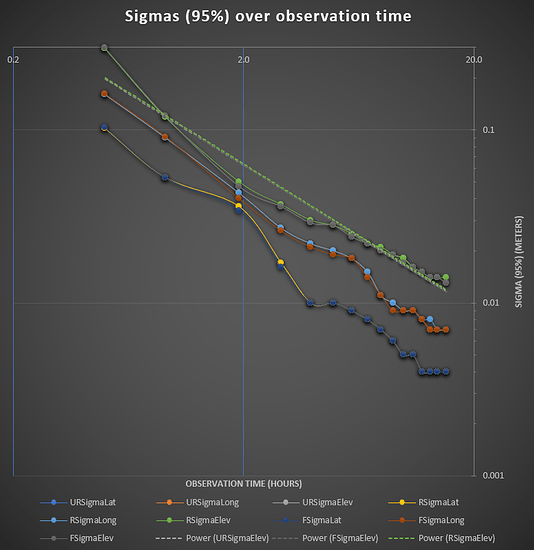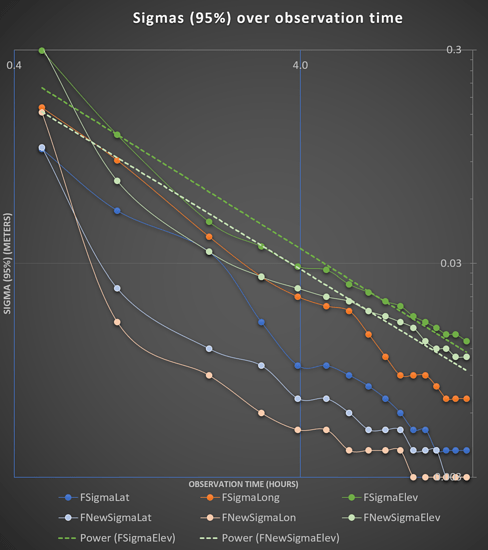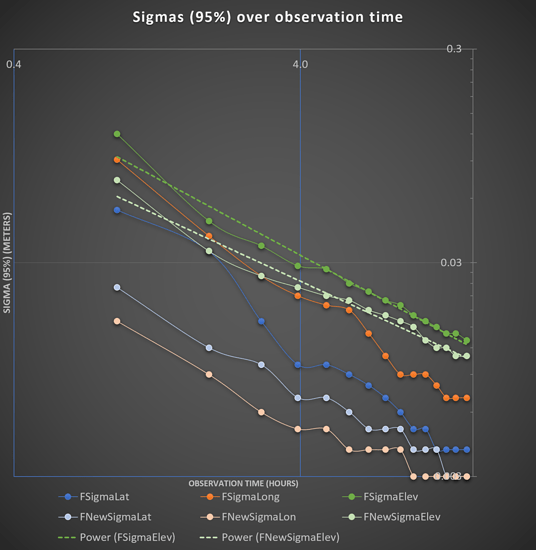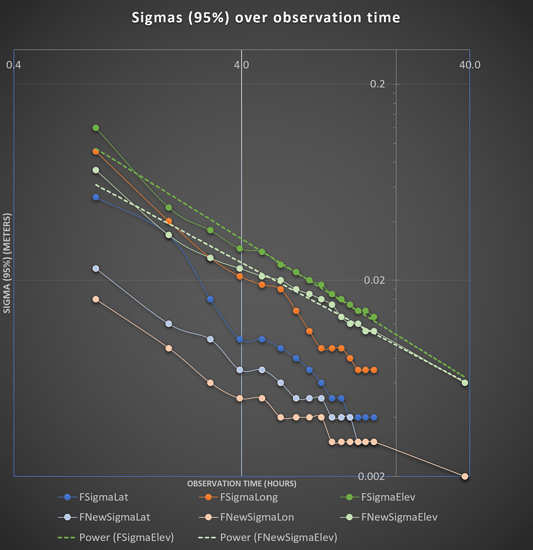Study of deviation (Sigma 95%) of PPP with RS2 with different observation-times.
This small study does not evaluate the absolute accuacy of PPP, but instead focuses on the spread or deviation of the collected points of the PPP solution.
One way to express this is Sigma (95%), which essentially means that 95% of the collected points have standard deviation lower than this numbers.
In Denmark RTK/RTN network subscriptions are expensive for a 1-man operation. Public (EUREF) CORS stations are 150-200 km apart. That leaves PPP (Precise Point Positioning) when establishing a base-point on a job-site.
I have collected 1 raw log for ~15 hours. Then I have made 16 different rinex-logs out of it, seperated in to 30m, 1h, 2h, 3h, nh, …, 15h logs.
All logs were then submitted to NRCAN PPP services as static. First in the timeframe that gave back NRCAN Ultra Rapid solution, and then NRCAN Rapid Solutions. I will also post the results for NRCAN Final, when they become available (2-3 weeks from now).
Sigma (95%) for Latitude, Longitude and Elevation for each duration and for each solutions were then plotted in Excel. On the basis of that, a logarithmic graph was made, to make the small difference more visible.
As you can see, NRCAN Ultra Rapid and NRCAN Rapid seem to be more or less identical, with Ultra Rapid actually being a tiny bit better.
From the data, it seem like 5-8 hours is the sweet-spot for Ultra Rapid / Rapid.
Really looking forward to the NRCAN Final solution becoming available!
For those wanting the raw-numbers, here they are:
| Obstime (h) | URSigmaLat | URSigmaLong | URSigmaElev | RSigmaLat | RSigmaLong | RSigmaElev |
|---|---|---|---|---|---|---|
| 0,5 | 0,102 | 0,16 | 0,295 | 0,102 | 0,16 | 0,295 |
| 0,9 | 0,053 | 0,09 | 0,119 | 0,053 | 0,09 | 0,118 |
| 1,9 | 0,036 | 0,043 | 0,047 | 0,036 | 0,043 | 0,05 |
| 2,9 | 0,017 | 0,027 | 0,036 | 0,017 | 0,027 | 0,037 |
| 3,9 | 0,01 | 0,022 | 0,029 | 0,01 | 0,022 | 0,03 |
| 4,9 | 0,01 | 0,02 | 0,028 | 0,01 | 0,02 | 0,028 |
| 5,9 | 0,009 | 0,018 | 0,024 | 0,009 | 0,018 | 0,025 |
| 6,9 | 0,008 | 0,015 | 0,022 | 0,008 | 0,015 | 0,022 |
| 7,9 | 0,007 | 0,011 | 0,02 | 0,007 | 0,011 | 0,021 |
| 8,9 | 0,006 | 0,01 | 0,019 | 0,006 | 0,01 | 0,019 |
| 9,9 | 0,005 | 0,009 | 0,018 | 0,005 | 0,009 | 0,018 |
| 10,9 | 0,005 | 0,009 | 0,016 | 0,005 | 0,009 | 0,016 |
| 11,9 | 0,004 | 0,008 | 0,015 | 0,004 | 0,008 | 0,015 |
| 12,9 | 0,004 | 0,007 | 0,014 | 0,004 | 0,008 | 0,014 |
| 13,9 | 0,004 | 0,007 | 0,014 | 0,004 | 0,007 | 0,014 |
| 15,2 | 0,004 | 0,007 | 0,013 | 0,004 | 0,007 | 0,014 |
Update to follow when NRCAN Final is available.









